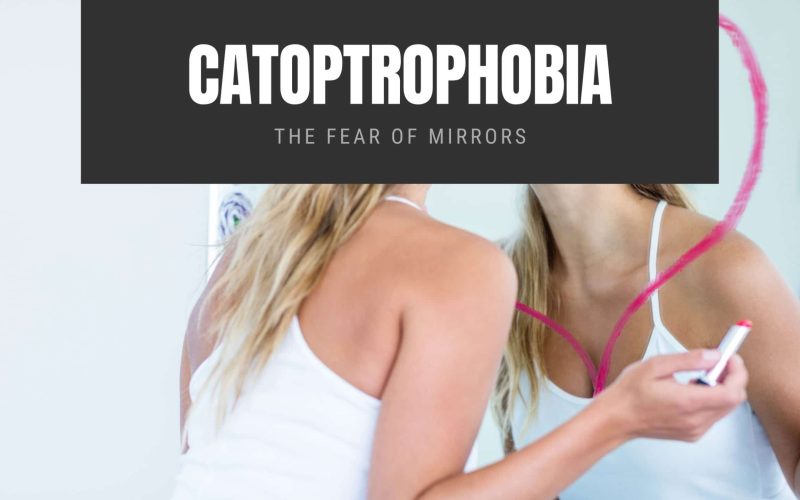The fear of mirrors or the anxiety towards mirror reflections is generally known as catoptrophobia, spectrophobia, or Eisoptrophobia.
The fear of mirrors or the anxiety towards mirror reflections is usually known as catoptrophobia, spectrophobia, or Eisoptrophobia.
Catoptrophobia is derived from two Latin words – Katopron, the word for mirror, and Phobos, which means fear. Most individuals with this fear are not particularly scared of the mirror.
What they are afraid of is the reflection within the mirror. The fear of mirrors is a relatively rare one and also a highly personalized one.
Some people are scared of what they look like in the mirror, others are scared of reflected words, and others are scared of the mirror’s likely link with the supernatural.
These three reflections related to fear are explained below.
Fear of Mirrors due to Body Image
People uncomfortable with their body image might try to avoid seeing themselves in a mirror. Some people go as far as refusing to pose for pictures or to allow any form of audio or video recording.
Generally, individuals with mirror phobias related to body image do not have a problem installing a mirror somewhere around. However, they will go out of their way to personally evade them.
Fear of Reflections
Fear of mirrors may be linked to a more generalized fear of all forms of reflection.
In addition to standing or other mirrors, you may be scared of any reflective material like stainless steel water bottles, highly polished cars, or certain types of sunglasses.
Reflections mostly distort the items reflected, causing them to look slightly unreal. Some people are particularly frightened by reflected writing, which appears like gibberish.
Supernatural Fears
Mirrors have long been connected to superstitions and religious rituals. An ancient belief suggests that a mirror reflects the soul of a person.
According to that same belief, a person’s soul regenerates every seven years. This means that when you break a mirror, you have broken a piece of your soul, causing seven years of bad luck.
Likewise, there are many cultures where the mirrors in a newly deceased person’s home must be covered to avoid trapping the person’s soul.
The relationship between the soul and a mirror has led to various urban legends. Some say mirrors serve as a portal between the present world and the next. When a person sees a reflection that should not exist, it is said to be a bad omen.
Likewise, there is a popular children’s game called Bloody Mary, where kids allegedly summon an evil being through a bathroom mirror.
All mirror phobias that are based on the supernatural are mostly rooted in religious beliefs and customs. They may be connected with fears of witchcraft, death, and ghosts.
Causes of Catoptrophobia
Catoptrophobia, as mentioned earlier, might be triggered by preconceived notions of body image and beauty. Many ladies who do not have perfect curves or who are overweight, for example, tend to shun looking into mirrors or posing for personal or group photographs.
Naturally, these people do not have a phobia but try to avoid mirrors or reflective surfaces as much as possible.
The difference between them and those with a phobia is that these folks do not necessarily mind the presence of mirrors around them.
A bulk of the cases of phobia for mirrors have their origin in the early past. The earliest identified fear of mirrors can be traced back to man’s fear of still waters.
Before the birth of modern advances, man did not use mirrors; rather, they only saw their reflection in still waters of rivers, lakes, etc. They often assumed that what they saw was “their soul staring back at them.”
This assumption gave rise to the belief that the ‘human soul could be detached from the body even before a person’s death.’ Many ancient folktales were also formed around this concept.
For instance, there is a popular story about the disturbance in a person’s reflection in a lake that eventually led to impending disaster or doom. This led to an association between broken/shattered mirrors and bad luck/death.
To date, a shattered mirror implies “seven years of bad luck.” Many African tribes also associate a person’s reflection in the dark, still waters with death.
These people avoid looking in such waters out of the fear that crocodiles/evil spirits may kill them by snapping away at their reflection and stealing away their souls.
In several cultures, kids that are less than a year old are not allowed to look in a mirror because of the belief that the kids might die when shown their reflection.
Brides cannot look in a mirror when dressed in their wedding finery. (However, the newlyweds may look together as a couple in a mirror since this is auspicious).
Thus, because of the many superstitions attached to mirrors, it is not rare to see them in horror movies or read about them in horror stories. These negative depictions may lead to catoptrophobia in some young or highly superstitious people.
Catoptromancy or mirror divination is another mirror-related topic that might lead to a fear of mirrors. Mirror divination was a kind of black magic practiced by people early in the 17th century.
Catopathic practitioners would dip a metallic mirror into the water and keenly study the reflection of the sick person to decide whether he would survive or not accordingly.
Pop culture, movies (e.g., Oculus), media, and books show evil spirits trapped in mirrors coming out to haunt people.
They also make it seem like vampires do not have a reflection because they do not have souls. Concepts such as these might also lead to the fear of mirrors.
Some schizophrenic individuals or those who have adrenal insufficiencies also tend to report Catoptrophobia.
Symptoms of Catoptrophobia
An exaggerated or constant fear of mirrors may cause many of the following symptoms:
- Trembling/shaking
- Thoughts of death or dying
- Avoidance of mirrors
- Rapid heartbeat, shallow breathing, dilated pupils, sweating excessively
- Screaming, crying, trying to flee
- Full-blown anxiety or panic attacks
Treatment
The best way to treat or manage the fear of mirror phobia or any other kind of fear is by taking baby steps.
- One of the forms of therapy that may be helpful is gradual exposure therapy. This therapy can help an individual progress slowly to overcoming his fear permanently. In this therapy, a person will start by looking at pictures of mirrors, thinking about them, and finally progress to holding and looking inside a mirror.
- Homeopathic remedies, and herbs etc. may also help to relieve anxiety that is associated with this phobia. Chamomile, Lavandula, etc, are a few examples.
- Talk therapy, online and offline support groups, and more can also help. Having family around you is also helpful.
- NLP therapy, Psychotherapy, and hypnotherapy are some good methods that are effective in treating catoptrophobia.








